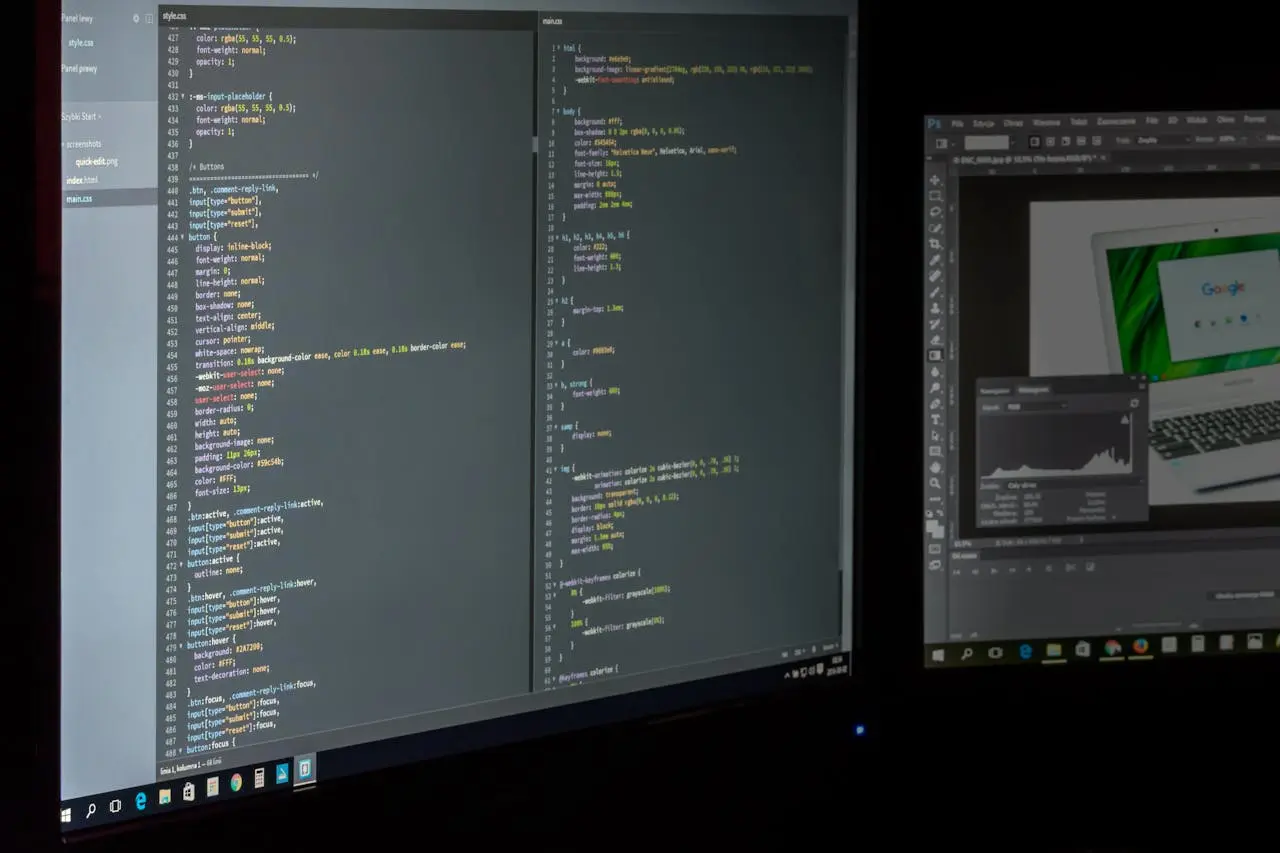Structure of a C program
As we have already seen, to solve a problem there are three main things to be
considered. Firstly, what should be the output? Secondly, what should be the inputs
that will be required to produce this output and thirdly, the steps of instructions which
use these inputs to produce the required output. As stated earlier, every programming
language follows a set of rules; therefore, a program written in C also follows
predefined rules known as syntax. C is a case sensitive language. All C programs
consist of one or more functions. One function that must be present in every C
program is main(). This is the first function called up when the program execution
begins. Basically, main() outlines what a program does. Although main is not given
in the keyword list,it cannot be used for naming a variable. The structure of a C
program is illustrated below where functions func1( ) through funcn( )
represent user defined functions.
Preprocessor directives
Global data declarations
main ( ) /* main function*/
{
Declaration part;
Program statements;
}
/*User defined functions*/
func1( ) {
…………
}
func2 ( )
{
…………
}
.
.
.
funcn ( )
{
…………
}
A Simple C Program
From the above sections, you have become familiar with, a programming language
and structure of a C program. It’s now time to write a simple C program. This
program will illustrate how to print out the message “This is a C program”.
What is program and what is a programming language
We have seen in the previous unit that a computer has to be fed with a detailed set of
instructions and data for solving a problem. Such a procedure which we call an
algorithm is a series of steps arranged in a logical sequence. Also we have seen that a
flowchart is a pictorial representation of a sequence of instructions given to the
computer. It also serves as a document explaining the procedure used to solve a
problem. In practice it is necessary to express an algorithm using a programming
language. A procedure expressed in a programming language is known as a computer
program.
Computer programming languages are developed with the primary objective of
facilitating a large number of people to use computers without the need for them to
know in detail the internal structure of the computer. Languages are designed to be
machine-independent. Most of the programming languages ideally designed, to
execute a program on any computer regardless of who manufactured it or what model
it is.
Programming languages can be divided into two categories:
- Low Level Languages or Machine Oriented Languages: The language
whose design is governed by the circuitry and the structure of the machine is
known as the Machine language. This language is difficult to learn and use. It
is specific to a given computer and is different for different computers i.e. these
languages are machine-dependent. These languages have been designed to
give a better machine efficiency, i.e. faster program execution. Such languages
are also known as Low Level Languages. Another type of Low-Level Language
is the Assembly Language. We will code the assembly language program in the
form of mnemonics. Every machine provides a different set of mnemonics to be
used for that machine only depending upon the processor that the machine is
using.
- High Level Languages or Problem Oriented Languages: These languages
are particularly oriented towards describing the procedures for solving the
problem in a concise, precise and unambiguous manner. Every high level
language follows a precise set of rules. They are developed to allow application
programs to be run on a variety of computers. These languages are machineindependent. Languages falling in this category are FORTRAN, BASIC,
PASCAL etc. They are easy to learn and programs may be written in these
languages with much less effort. However, the computer cannot understand
them and they need to be translated into machine language with the help of
other programs known as Compilers or Translators.
C Language
Prior to writing C programs, it would be interesting to find out what really is C
language, how it came into existence and where does it stand with respect to other
computer languages. We will briefly outline these issues in the following section.
History of C
C is a programming language developed at AT&T’s Bell Laboratory of USA in 1972.
It was designed and written by Dennis Ritchie. As compared to other programming
languages such as Pascal, C allows a precise control of input and output.
25
Now let us see its historical development. Basics of C The late 1960s were a turbulent era for
computer systems research at Bell Telephone Laboratories. By 1960, many
programming languages came into existence, almost each for a specific purpose. For
example COBOL was being used for Commercial or Business Applications,
FORTRAN for Scientific Applications and so on. So, people started thinking why
could not there be a one general purpose language. Therefore, an International
Committee was set up to develop such a language, which came out with the invention
of ALGOL60. But this language never became popular because it was too abstract and
too general. To improve this, a new language called Combined Programming
Language (CPL) was developed at Cambridge University. But this language was very
complex in the sense that it had too many features and it was very difficult to learn.
Martin Richards at Cambridge University reduced the features of CPL and developed
a new language called Basic Combined Programming Language (BCPL). But
unfortunately it turned out to be much less powerful and too specific. Ken Thompson
at AT & T’s Bell Labs, developed a language called B at the same time as a further
simplification of CPL. But like BCPL this was also too specific. Ritchie inherited the
features of B and BCPL and added some features on his own and developed a
language called C. C proved to be quite compact and coherent. Ritchie first
implemented C on a DEC PDP-11 that used the UNIX Operating System.
For many years the de facto standard for C was the version supplied with the UNIX
version 5 operating system. The growing popularity of microcomputers led to the
creation of large number of C implementations. At the source code level most of these
implementations were highly compatible. However, since no standard existed there
were discrepancies. To overcome this situation, ANSI established a committee in
1983 that defined an ANSI standard for the C language.
Salient features of C
C is a general purpose, structured programming language. Among the two types of
programming languages discussed earlier, C lies in between these two categories.
That’s why it is often called a middle level language. It means that it combines the
elements of high level languages with the functionality of assembly language. It
provides relatively good programming efficiency (as compared to machine oriented
language) and relatively good machine efficiency as compared to high level
languages). As a middle level language, C allows the manipulation of bits, bytes and
addresses – the basic elements with which the computer executes the inbuilt and
memory management functions. C code is very portable, that it allows the same C
program to be run on machines with different hardware configurations. The flexibility
of C allows it to be used for systems programming as well as for application
programming.
C is commonly called a structured language because of structural similarities to
ALGOL and Pascal. The distinguishing feature of a structured language is
compartmentalization of code and data. Structured language is one that divides the
entire program into modules using top-down approach where each module executes
one job or task. It is easy for debugging, testing, and maintenance if a language is a
structured one. C supports several control structures such as while, do-while and for
and various data structures such as strucs, files, arrays etc. as would be seen in the
later units. The basic unit of a C program is a function - C’s standalone subroutine.
The structural component of C makes the programming and maintenance easier.
Structure of a C program
As we have already seen, to solve a problem there are three main things to be
considered. Firstly, what should be the output? Secondly, what should be the inputs
that will be required to produce this output and thirdly, the steps of instructions which
use these inputs to produce the required output. As stated earlier, every programming
language follows a set of rules; therefore, a program written in C also follows
predefined rules known as syntax. C is a case sensitive language. All C programs
consist of one or more functions. One function that must be present in every C
program is main(). This is the first function called up when the program execution
begins. Basically, main() outlines what a program does. Although main is not given
in the keyword list,it cannot be used for naming a variable. The structure of a C
program is illustrated below where functions func1( ) through funcn( )
represent user defined functions.
Preprocessor directives
Global data declarations
main ( ) /* main function*/
{
Declaration part;
Program statements;
}
/*User defined functions*/
func1( ) {
…………
}
func2 ( )
{
…………
}
.
.
.
funcn ( )
{
…………
}
A Simple C Program
From the above sections, you have become familiar with, a programming language
and structure of a C program. It’s now time to write a simple C program. This
program will illustrate how to print out the message “This is a C program”.
Writing a C Program
A C program can be executed on platforms such as DOS, UNIX etc. DOS stores C program with a file extension .c. Program text can be entered using any text editor such as EDIT or any other. To edit a file called testprog.c using edit editor, gives:
C:> edit testprog.c
If you are using Turbo C, then Turbo C provides its own editor which can be used for writing the program. Just give the full pathname of the executable file of Turbo C and you will get the editor in front of you. For example:
C:> turboc\bin\tc
Here, tc.exe is stored in bin subdirectory of turboc directory. After you get the menu just type the program and store it in a file using the menu provided. The file automatically gets the extension of .c.
UNIX also stores C program in a file with extension is .c. This identifies it as a C program. The easiest way to enter your text is using a text editor like vi, emacs or xedit. To edit a file called testprog.c using vi type
$ vi testprog.c
The editor is also used to make subsequent changes to the program
Compiling a C Program
After you have written the program the next step is to save the program in a file with
extension . c . This program is in high-level language. But this language is not
understood by the computer. So, the next step is to convert the high-level language
program (source code) to machine language (object code). This task is performed by a
software or program known as a compiler. Every language has its own compiler that
converts the source code to object code. The compiler will compile the program
successfully if the program is syntactically correct; else the object code will not be
produced.

The C Compiler
If you are working on UNIX platform, then if the name of the program file is
testprog.c, to compile it, the simplest method is to type
cc testprog.c
This will compile testprog.c, and, if successful, will produce a executable file called
a.out. If you want to give the executable file any other, you can type
cc testprog.c -o testprog
This will compile testprog.c, creating an executable file testprog.
If you are working with TurboC on DOS platform then the option for compilation is
provided on the menu. If the program is syntactically correct then this will produce a
file named as testprog.obj. If not, then the syntax errors will be displayed on the
screen and the object file will not be produced. The errors need to be removed before
compiling the program again. This process of removing the errors from the program is
called as the debugging.
Syntax and Semantic Errors
Every language has an associated grammar, and the program written in that language
has to follow the rules of that grammar. For example in English a sentence such a
“Shyam, is playing, with a ball”. This sentence is syntactically incorrect because
commas should not come the way they are in the sentence.
Likewise, C also follows certain syntax rules. When a C program is compiled, the
compiler will check that the program is syntactically correct. If there are any syntax
errors in the program, those will be displayed on the screen with the corresponding
line numbers.
Apart from syntax errors, another type of Basics of C errors that are shown while compilation are
semantic errors. These errors are displayed as warnings. These errors are shown if a
particular statement has no meaning. The program does compile with these errors, but
it is always advised to correct them also, since they may create problems while
execution. The example of such an error is that say you have declared a variable but
have not used it, and then you get a warning “code has no effect”. These variables are
unnecessarily occupying the memory.
Link and run the C program
After compilation, the next step is linking the program. Compilation produces a file
with an extension .obj. Now this .obj file cannot be executed since it contains calls to
functions defined in the standard library (header files) of C language. These functions
have to be linked with the code you wrote. C comes with a standard library that
provides functions that perform most commonly needed tasks. When you call a
function that is not the part of the program you wrote, C remembers its name. Later
the linker combines the code you wrote with the object code already found in the
standard library. This process is called linking. In other words, Linker is a program
that links separately compiled functions together into one program. It combines the
functions in the standard C library with the code that you wrote. The output of the
linker in an executable program i.e., a file with an extension .exe.
Run the C Program Through the Menu
When we are working with TurboC in DOS environment, the menu in the GUI that
pops up when we execute the executable file of TurboC contains several options for
executing the program:
- Link, after compiling
- Make compiles as well as links
- Run
All these options create an executable file and when these options are used we also get
the output on user screen. To see the output we have to shift to user screen window.
Run From an Executable File
An .exe file produced by can be directly executed.
UNIX also includes a very useful program called make. Make allows very
complicated programs to be compiled quickly, by reference to a configuration file
(usually called makefile). If your C program is a single file, you can usually use make
by simply typing –
make testprog
This will compile testprog.c as well as link your program with the standard library so
that you can use the standard library functions such as printf and put the executable
code in testprog.
In case of DOS environment , the options provided above produce an executable file
and this file can be directly executed from the DOS prompt just by typing its name
without the extension. That is if the name of the program is test.c, after compiling and
linking the new file produced is test.exe only if compilation and linking is successful.
This can be executed as:
c>test
Linker Errors
If a program contains syntax errors then the program does not compile, but it may
happen that the program compiles successfully but we are unable to get the executable
file, this happens when there are certain linker errors in the program. For example, the
object code of certain standard library function is not present in the standard C library;
the definition for this function is present in the header file that is why we do not get a
compiler error. Such kinds of errors are called linker errors. The executable file would
be created successfully only if these linker errors are corrected.
Logical and Runtime Errors
After the program is compiled and linked successfully we execute the program. Now
there are three possibilities:
- The program executes and we get correct results,
- The program executes and we get wrong results, and
- The program does not execute completely and aborts in between
The first case simply means that the program is correct. In the second case, we get
wrong results; it means that there is some logical mistake in our program. This kind of
error is known as logical error. This error is the most difficult to correct. This error is
corrected by debugging. Debugging is the process of removing the errors from the
program. This means manually checking the program step by step and verifying the
results at each step. Debugging can be made easier by a tracer provided in Turbo C
environment.
Diagrammatic representation of program execution process






John Doe
5 min agoLorem ipsum dolor sit amet, consectetur adipisicing elit, sed do eiusmod tempor incididunt ut labore et dolore magna aliqua. Ut enim ad minim veniam, quis nostrud exercitation ullamco laboris nisi ut aliquip ex ea commodo consequat.
ReplyJohn Doe
5 min agoLorem ipsum dolor sit amet, consectetur adipisicing elit, sed do eiusmod tempor incididunt ut labore et dolore magna aliqua. Ut enim ad minim veniam, quis nostrud exercitation ullamco laboris nisi ut aliquip ex ea commodo consequat.
Reply